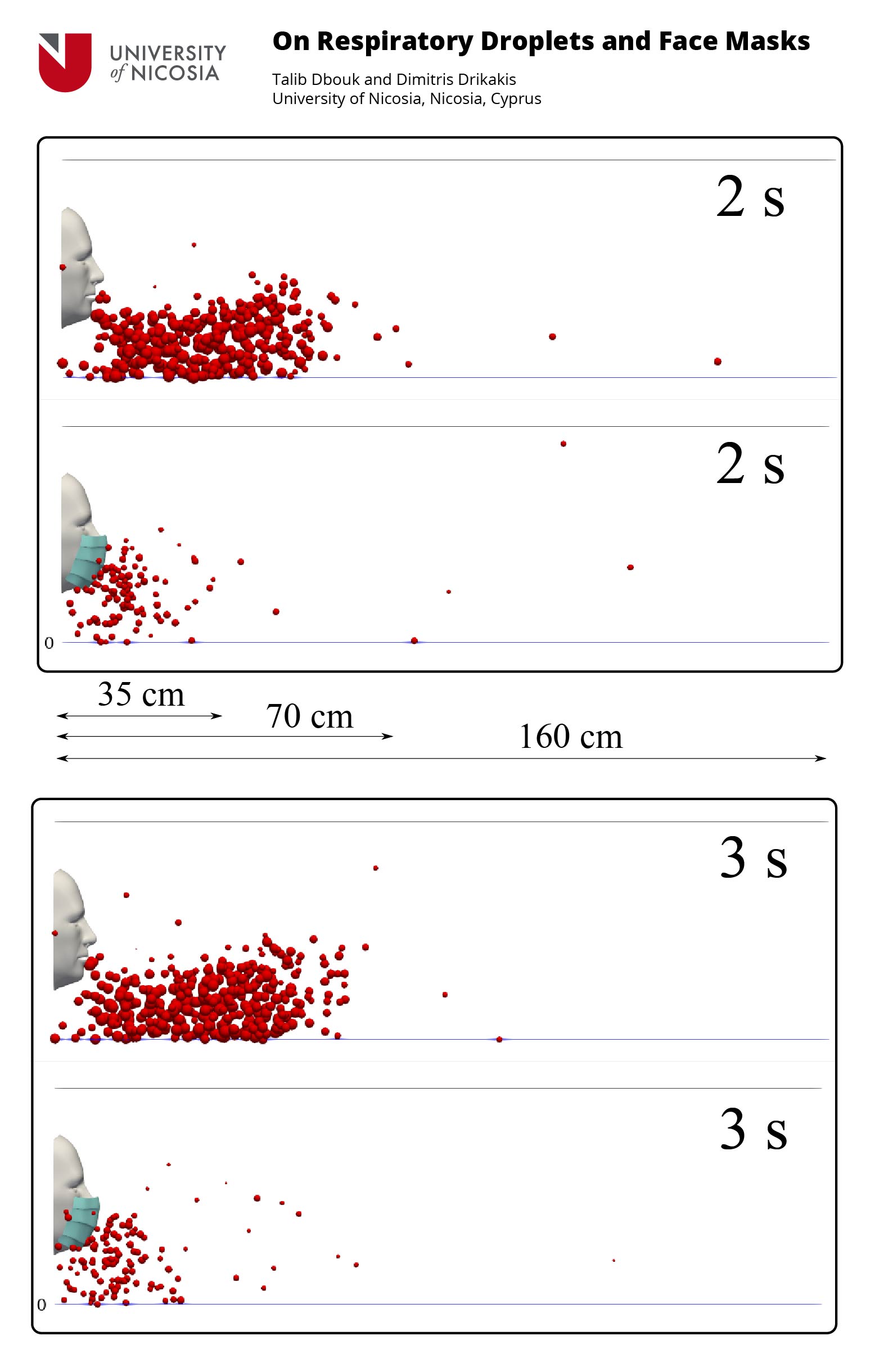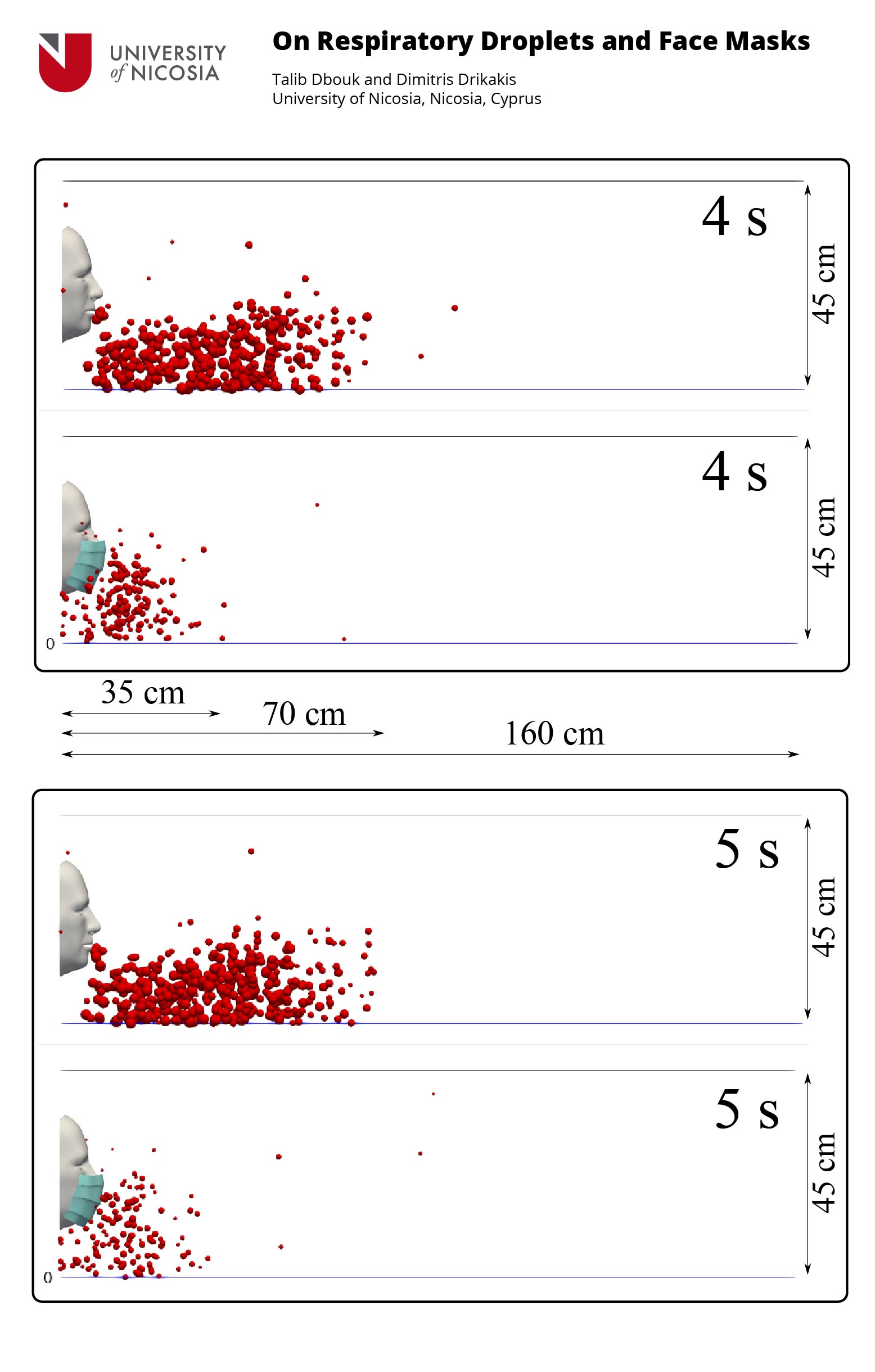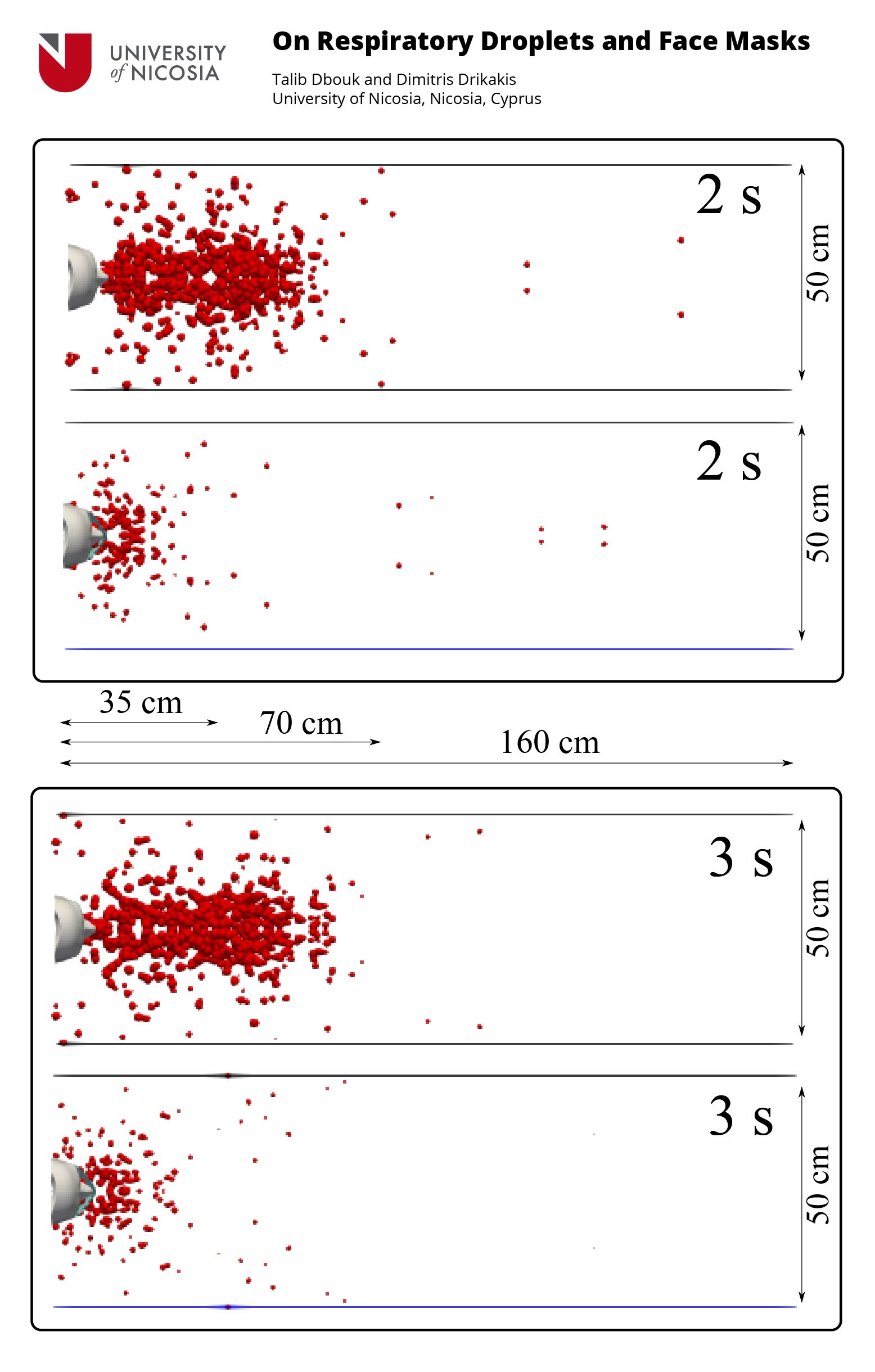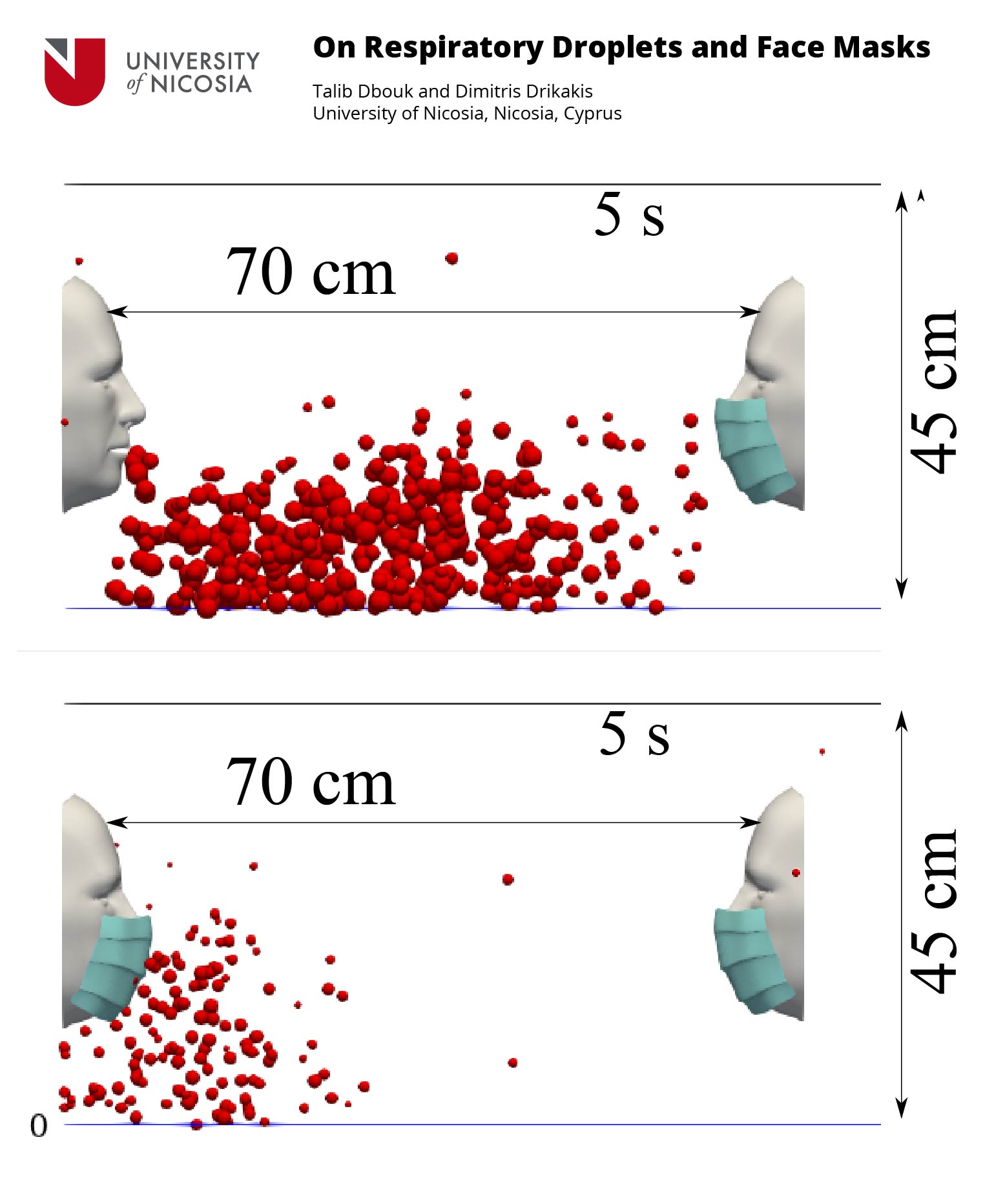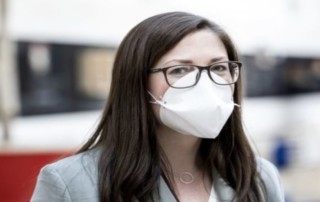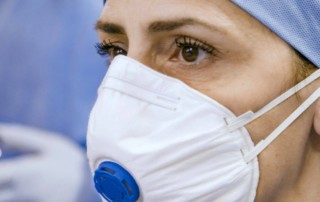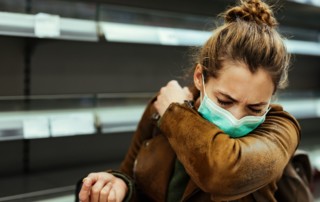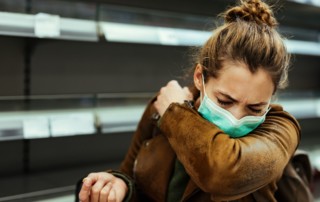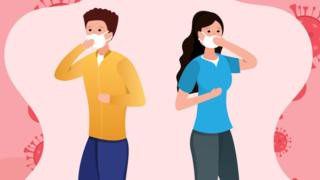COVID-19
UNIC Coronavirus Health and Research Portal
On Respiratory Droplets and Face Masks
Talib Dbouk and Dimitris Drikakis
University of Nicosia, Nicosia, Cyprus
Face mask filters – textile, surgical or respiratory – are widely used in the effort to limit the spread of airborne viral infections. Our understanding of the droplet dynamics around a face mask filter, including the droplet containment, leakage from and passing through the cover, is incomplete.
The authors present a fluid dynamics study of the transmission of respiratory droplets through and around a face mask filter. By employing multiphase computational fluid dynamics Dbouk & Drikakis investigate the droplet dynamics induced by a mild coughing incident and examine the fluid dynamics phenomena affecting the mask efficiency. The model takes into account turbulent dispersion forces, droplet phase-change, evaporation, and breakup in addition to the droplet–droplet and droplet–air interactions. The model mimics real events by using data which closely resemble cough experiments.
The study shows that the criteria employed for assessing the face mask performance must be modified to take into account: the penetration dynamics of airborne droplet transmission, the fluid dynamics leakage around the filter, and reduction of efficiency during cough cycles. A new criterion for calculating more accurately the mask efficiency by taking into account the penetration dynamics, is proposed.
We show that the use of masks will reduce the airborne droplet transmission and will also protect the wearer from the droplets expelled from other subjects. However, many droplets still spread around and away from the cover, cumulatively, during cough cycles. Therefore, the use of a mask does not provide complete protection, and social distancing remains important during a pandemic. The implications of the reduced mask efficiency and respiratory droplet transmission away from the mask are even more critical for healthcare workers. The results of this study provide evidence of droplet transmission prevention by face masks, which can guide their use and further improvement.
Figure 1
A subject coughing in a cyclic incidence. A qualitative examination of airborne droplet transmission with and without wearing a surgical mask. The top and bottom figures show the results at 2 s and 3 s, respectively. Wearing a surgical mask that exhibits an initial efficiency of ∼91%. This cannot prevent the transport of the saliva droplets away from the subject. Many droplets penetrate the mask shield and some saliva droplet disease-carrier particles can travel more than 1.2 m. For visualization, the droplets were scaled by a factor of 600 compared to their actual size. The environmental conditions are zero wind speed, ambient temperature 20 ○C, pressure 1 atm, and relative humidity 50%. The mouth temperature is 34 ○C and the face skin temperature is 32 ○C.
Figure 2
A subject coughing in a cyclic incidence. A qualitative examination of airborne droplet transmission with and without wearing a surgical mask. The top and bottom figures show the results at 4 s and 5 s, respectively. Wearing a surgical mask that exhibits initial efficiency of ∼91%. This cannot prevent the transport of the saliva droplets away from the subject. Many droplets penetrate the mask shield and some saliva droplet disease-carrier particles can travel more than 1.2 m. For visualization, the droplets were scaled by a factor of 600 compared to their actual size. The environmental conditions are zero wind speed, ambient temperature 20 ○C, pressure 1 atm, and relative humidity 50%. The mouth temperature is 34 ○C, and the face skin temperature is 32 ○ C.
Figure 3
A subject coughing in a cyclic incidence. Top view of a qualitative examination of airborne droplet transmission with and without wearing a surgical mask. The top and bottom figures show the results at 2 s and 3 s, respectively. We consider a surgical mask that exhibits initial efficiency of ∼91%. The cover does not prevent the transport of the saliva droplets entirely away from the subject. Many droplets penetrate the mask shield, and some saliva droplet disease-carrier particles can travel more than 1.2 m. For visualization, the droplets were scaled by a factor of 600 compared to their actual size. The environmental conditions are zero wind speed, ambient temperature 20 ○C, pressure 1 atm, and relative humidity 50%. The mouth temperature is 34 ○C, and the face skin temperature is 32 ○C.
Figure 4
A subject coughing in a cyclic incidence. Top view of airborne droplet transmission with and without wearing a surgical mask. The top and bottom figures show the results at 4 s and 5 s, respectively. We consider a surgical mask that exhibits an initial efficiency of ∼91%. The cover does not prevent the transport of the saliva droplets entirely away from the subject. Many droplets penetrate the mask shield and some saliva droplet disease-carrier particles can travel more than 1.2 m. For visualization, the droplets were scaled by a factor of 600 compared to their actual size. The environmental conditions are zero wind speed, ambient temperature 20 ○C, pressure 1 atm, and relative humidity 50%. The mouth temperature is 34 ○C, and the face skin temperature is 32 ○C.
Figure 5
Mask wearer: subjects wearing a mask will reduce the respiratory droplet transmission while (partially) shielding themselves from other subjects experiencing a coughing incident. We show the results at 5 s simulation time for a surgical mask exhibiting an initial efficiency of ∼91%. The environmental conditions are zero wind speed, ambient temperature 20 ○C, pressure 1 atm, and relative humidity 50%. The mouth temperature is 34 ○C and the face skin temperature is 32 ○C.
What Does This Mean?
According to the results of this study, the authors made recommendations that are summarised below:
- Although masks will reduce the droplet transmission, we should not ignore that several droplets will be transmitted away from the mask. The use of a mask will not provide complete prevention from airborne droplet transmission. The above is particularly important, both for indoor and outdoor environments. As Dbouk and Drikakis showed in a previous study (https://aip.scitation.org/doi/10.1063/5.0011960) respiratory droplets can be transmitted to several meters away from the subject due to wind conditions. Therefore, social distancing remains essential when facing an evolving pandemic.
- The above recommendation implies that we can protect healthcare workers only if we equip them with a complete PPE, e.g., completely a helmet with a built-in air filter, a face shield together with a disposable suit over the whole ensemble and a double set of gloves.
- The manufacturers and regulatory authorities should consider new criteria for assessing mask performance, to account for the flow physics and cough dynamics. The authors provided a simple criterion that takes into account the efficiency reduction during a cyclic coughing incident.
Video 1
A subject coughing in a cyclic incidence. A qualitative examination of airborne droplet transmission with and without wearing a surgical mask.
The University of Nicosia (UNIC)
About the University of Nicosia
The University of Nicosia (UNIC) is the largest university in Cyprus, and the largest university in southern Europe that teaches primarily in English, welcoming 12,000+ students from over 70 countries worldwide. The University of Nicosia is a comprehensive university with 6 schools, 20 departments and over 100 degree programs offered on-campus and online.
The University of Nicosia is best known in the fields of medicine, law, blockchain, accounting, education, forecasting and international relations and for a series of partnerships with other leading European universities. UNIC was most recently ranked #106 in its region by QS and #300 to #400 globally in the Times Higher Education Impact rankings.
To learn more about the University of Nicosia, please see: https://www.unic.ac.cy/
UNIC’s COVID-19 Response
University of Nicosia faculty across a variety of academic disciplines are actively engaged in research and analysis and serving in scientific / public policy roles supporting the global COVID-19 response.
For more information about the University of Nicosia’s work relating to COVID-19 including potential collaboration, please see: https://www.unic.ac.cy/coronavirus/
Contact Information
For more information about this study, please contact Prof Dimitris Drikakis at [email protected].
For more information on our COVID-19 related research in general, please contact UNIC at [email protected].
Press Coverage
Articles and press mentions in global media about the research.
Keep your distance; new study on coughing shows masks help, not perfect
Keep your distance; new study on coughing shows masks help, not perfect Several Port Aransas business owners are happy about the facemask order that will become law on Wednesday. As the debate about mask mandates continues in some states, a new study reportedly shows social distancing is just as important to reduce the spread of COVID-19. The study looked at the effectiveness of face coverings when someone coughs repeatedly, coughing is one of the symptoms of COVID-19. The study was [...]
Keep your distance; new study on coughing shows masks help, not perfect
Keep your distance; new study on coughing shows masks help, not perfect As the debate about mask mandates continues in some states, a new study reportedly shows social distancing is just as important to reduce the spread of COVID-19. The study looked at the effectiveness of face coverings when someone coughs repeatedly, coughing is one of the symptoms of COVID-19. The study was published in a June issue of “Physics of Fluid”, by AIP Publishing, and was conducted by Talib [...]
La tos persistente merma la eficacia de filtrado de los cubrebocas, revelan investigadores
Un trabajo previo de este grupo de investigación mostró que las gotas de saliva pueden viajar más de cinco metros en cinco segundos cuando una persona sin mascarilla tose. Este nuevo trabajo utilizó un modelo extendido para considerar el efecto de las máscaras faciales y los múltiples ciclos de tos. Un trabajo previo de este grupo de investigación mostró que las gotas de saliva pueden viajar más de cinco metros en cinco segundos cuando una persona sin mascarilla tose. Este [...]
Corona: Dieser Fehler macht die Mund-und Nasenmaske weniger sicher
Corona: Dieser Fehler macht die Mund-und Nasenmaske weniger sicher Mund- und Nasenmasken sollen die Gefahr einer Corona-Tröpfchenübertragung verringern. Doch diese (schwer zu verhindernde) Sache macht das Tragen weniger sicher Das Tragen einer Mund- und Nasenmaske ist vielerorts in Geschäften und in öffentlichen Verkehrsmitteln Pflicht, um die unkontrollierte Ausbreitung des Coronavirus zu verhindern. Hier haben wir bereits über häufige Maskenfehler aufgeklärt, doch es gibt eine weitere Sache, die das Tragen der Mund- und Nasenmaske weniger sicher macht. Nämlich Husten! Read the [...]
Can Covid-19 spread when someone coughs through a mask? This is what the science says | Health24
Can Covid-19 spread when someone coughs through a mask? This is what the science says | Health24 By now, Covid-19 is synonymous with facemasks, and even though the use of facemasks was still questioned earlier on in the pandemic, the World Health Organization has updated its guidelines on masks since then. Even though there is convincing literature to prove that a mask may reduce your risk of becoming infected with Covid-19 or infecting someone else, researchers have stated that face [...]
Consistent coughing degrades mask filters
The longer you wear a mask while coughing, the less efficient it becomes at keeping droplets in. There has been a growing body of evidence to show that face masks can reduce the transmission of viruses and prevent further spread of SARS-CoV-2. In Canada, face masks should fully cover the nose and mouth and there should not be any tears or holes. Canadian guidelines recommend cleaning your hands before and after touching the mask, and never wear a mask with [...]
Consistent coughing degrades mask filters
There has been a growing body of evidence to show that face masks can reduce the transmission of viruses and prevent further spread of SARS-CoV-2. In Canada, face masks should fully cover the nose and mouth and there should not be any tears or holes. Canadian guidelines recommend cleaning your hands before and after touching the mask, and never wear a mask with tears or holes. The guidelines also suggest changing a mask immediately if it becomes damp or dirty. Mayo [...]
Se viene el verano en la Sierra; con el viento el virus viaja más lejos : País : La Hora Noticias de Ecuador, sus provincias y el mundo
Las medidas actuales de separación física, que obligan a guardar dos metros de distancia entre personas para evitar el contagio del coronavirus, podrían ser insuficientes en determinadas condiciones ambientales, como la velocidad del viento, que puede propagar las gotas de saliva que se desprenden de la tos a más de 5 metros de distancia. Así lo advierte un estudio publicado en la revista científica ‘Physics of Fluids’, liderado por los investigadores Talib Dbouk y Dimitris Drikakis, del Instituto Americano de [...]
As Coronavirus Cases Spike, Here’s Where Masks Are Now Required
As Coronavirus Cases Spike, Here's Where Masks Are Now Required Eleven states now require every resident to wear a face covering while in public to help limit the spread of coronavirus, as the number of infections continues to surge across the country — with California becoming the latest addition Thursday... Read the full article here.
Coronavirus: People wearing masks standing three feet apart can transmit the disease
Coronavirus: People wearing masks standing three feet apart can transmit the disease Researchers have found that the coronavirus is able to flow between two people standing up to three feet apart even if one of them is wearing a surgical-grade face mask. The researchers belong from the University of Nicosia in Cyprus. They also added that masks also become less efficient when people repeatedly cough into them... Read the full article here.
